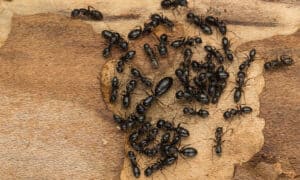Canada is a North American country with over 100 species of ants; it has some of the largest ants crawling on the earth. Although carpenter ants are the most common, they aren’t the only giant ants you can find in Canada. You can find these social insects anywhere in the world in the quadrillions (there could be at least 2.5 million ants for each person!) Let’s explore the giant ants you can expect to find crawling around Canada.
1. Black Carpenter Ants (Camponotus pennsylvanicus)
Black carpenter ants derive their name from their tendency to cut through wood to make their nests. Rather than eat the wood as termites do, black carpenter ants only chew it to make their homes. That explains why woodland forests are their preferred habitat.
Black carpenter ants have a predominantly dark body from the head to the abdomen (which is covered in yellowish hairs). They live in colonies with a winged queen, different from worker ants who don’t have wings.
Black carpenter ants can be as long as 0.5 inches long, with queens typically larger than worker ants. Though native to Canada, you can expect to find them in Eastern and Central America. The actions of Black carpenter ants to chew through wood technically make them pests – this is the case, especially if they chew through house wood and bring about immeasurable damage.
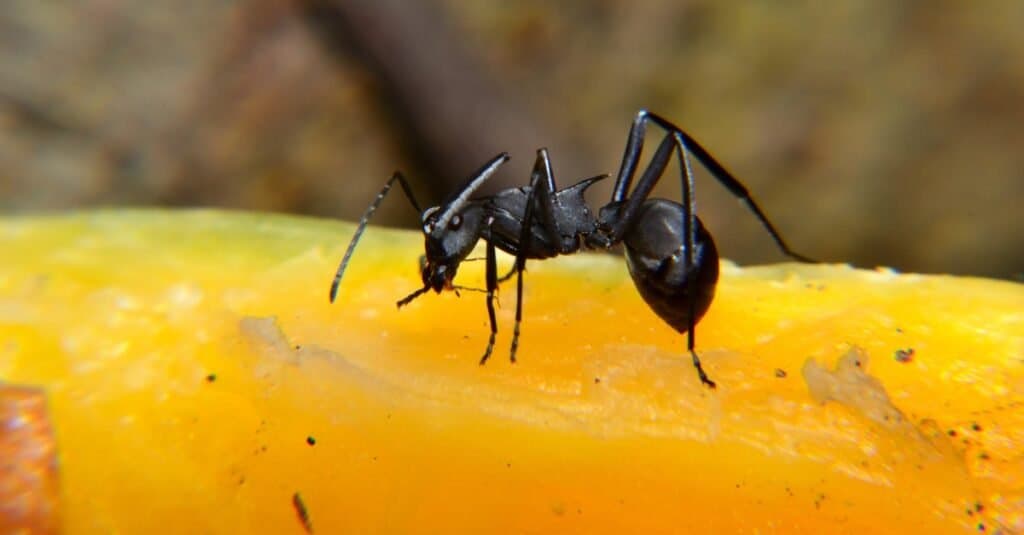
Black carpenter ants can be as long as 0.5 inches long, with the queens being typically larger than worker ants.
©Kras_Stock/Shutterstock.com
2. Slavemaker Ants (Formica sanguinea)
As their name suggests, slavemaker ants enslave other ants. They have an average large size of 0.4 inches which certainly aids in their enslaving duties. Because most ants aren’t that large, this is a major advantage for them.
Slavemaker ants invade other colonies led by their queen, who kills the new colony’s queen. They then force the new colony’s worker ants to work for them rather ingeniously for survival. Black ants (Formica lemani and Formica fusca) are their preferred targets.
Slavemaker ants have a blood-red coloration on their body except for the abdomen, which is black. That’s why they’re sometimes called blood-red ants. Although they’re primarily carnivores, they sometimes feed on berries, honeydew, and seeds which they steal from other insects, such as aphids.
Because they belong to the genus Formica, slavemaker ants boast an incredible defense mechanism. They secrete formic acid to defend themselves against their predators. Slavemaker ants are widespread across the UK, America, Europe, Africa, China, and Russia woodlands.
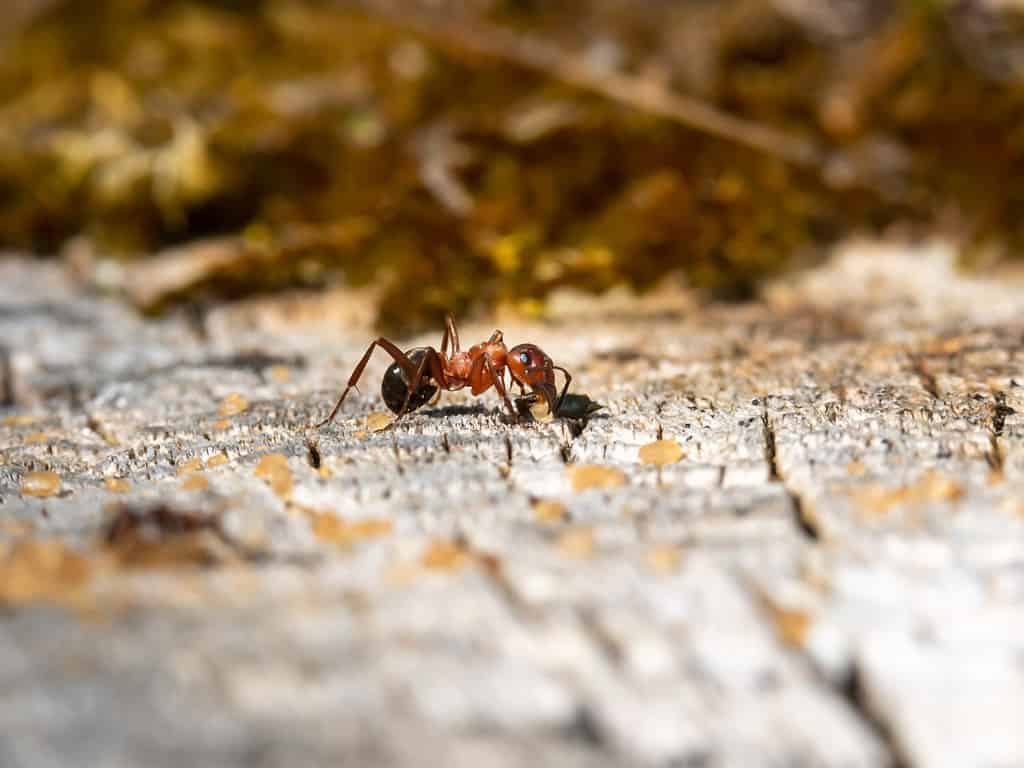
Slavemaker ants are larger than most other ants and use their size to invade other colonies in order to force the worker ants to work for them.
©Silvia Dubois/Shutterstock.com
3. Essig’s Carpenter Ant (Camponotus essigi)
Essig’s carpenter ants from the genus Camponotus are also found in Canada. Like their sister species, the black carpenter ants, they’re one of the largest ants crawling in Canada today.
They’re typical ants with a large queen that measures 0.3 to 0.4 inches long. Workers are typically smaller than the queen, measuring 0.12 to 0.4 inches long. These black ants also love to chew through wet wood to establish colonies.
Like their counterparts, these ants can be problematic if they infest your home. They could chew through the wooden structures to establish nests, leading to damages worth thousands of dollars.
Fortunately, it’s easy to keep them at bay; all you need to do is keep your house as dry as possible. Moist wood is a major attraction to these ants. Therefore, if you have an Essig’s carpenter ant infestation in your home, you may have a major moisture problem.
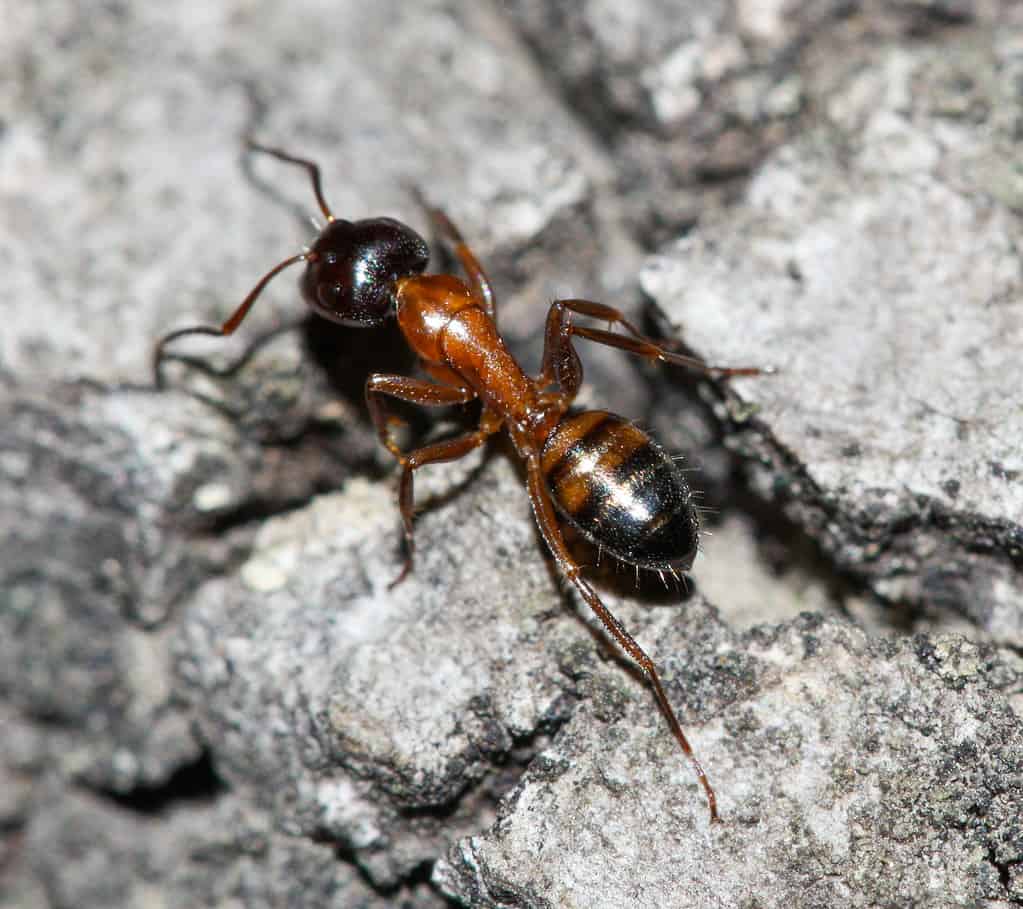
Essig’s carpenter ants are among the largest ants found in Canada today.
©Andrew Meeds, CC BY 4.0, via Wikimedia Commons – License
4. Tortugas Carpenter Ant (Camponotus tortuganus)
Another family member of the carpenter ants, the Tortugas carpenter ant, shares similar distinguishing factors as the other carpenter ants, including the colossal size. Adult workers range between 6 and 11 millimeters long, with queens reaching as high as 15 millimeters.
The Tortugas carpenter ant has a black abdomen with a yellowish head and thorax. These ants chew through wood to build nests and have colonies consisting of queen and worker ants.
They also feed on floral nectaries, aphids, mealybugs, and scale insects. They’re sometimes mistaken for the Florida carpenter ant, considering they’re quite similar in morphology. The Tortugas carpenter ants thrive in moist wooden forests in the southeastern and south-central parts of Canada.
You’ll also find them in parts of Florida and Alabama. Like other members of their genus, they also attack moist wood in homes and become a nuisance. They don’t sting but can spray formic acid that irritates the skin.

The Tortugas carpenter ant (
Camponotus tortuganus) is a member of the carpenter ant family known for its large size.
©April Nobile / © AntWeb.org – License
5. Pacific Field Ant (Formica pacifica)
An average body length of 6 to 9 mm boosts the Pacific field ants’ position as the largest ants crawling in Canada and North America. The queen can attain a maximum length between 8 and 12 mm.
These highly aggressive ant species attack neighboring colonies whenever they sense an attack on their territory. Their aggressive behavior makes them one of the most dominant ant species in the wild. There are few challengers for an ant that large.
Pacific field ants make forests and human settlements their home, building their nests under rocks or ordinary objects. Colonies at their peak can include several thousand worker ants.
These ants mainly feed on honeydew from aphids. To secure their food, they occasionally help small aphids get to all the parts of a plant.
Although they don’t sting, they have jagged teeth they use to bite intruders. They can also release formic acid from their abdomen when threatened. The acid can mildly irritate human skin, depending on the proximity. Because a colony grows fast, you should contact an exterminator for help in case of an infestation.

Although they don’t sting,
Formica pacificahave jagged teeth they use to bite intruders.
©April Nobile / © AntWeb.org – License
6. Black Garden Ant/ Common Black Ant (Lasius niger)
Another easy entrant to the list of the largest ants in Canada is the black garden ant. While males and worker ants may only grow to 4.5 mm in length, the queen can be an impressive 9 mm.
Black garden ants have a slim, long body with a shiny black shade. The workers have a glossy black appearance, almost similar to that of the queen, which has brown stripes on its abdomen. The males are regular black in appearance and have wings.
Interestingly, while hibernating, the queen digests her wings to gain more muscle since she can’t go out for food. That helps her grow larger than she was when she became queen. New queens are usually only 6 mm when starting a colony.
Garden ants eat tiny insects such as moths, farm aphids, fruits, nectar, beetles, and cockroaches to sustain their relatively large size. You’ll find their nests underground below stones, under plant roots, or rotten wood.
Although colonies usually have between 4,000 and 7,000 ants, that number can rise to as high as 40,000 in unique cases.
Fun Fact: The black garden ant queen can live for as long as 29 years, the longest among all the ant species.
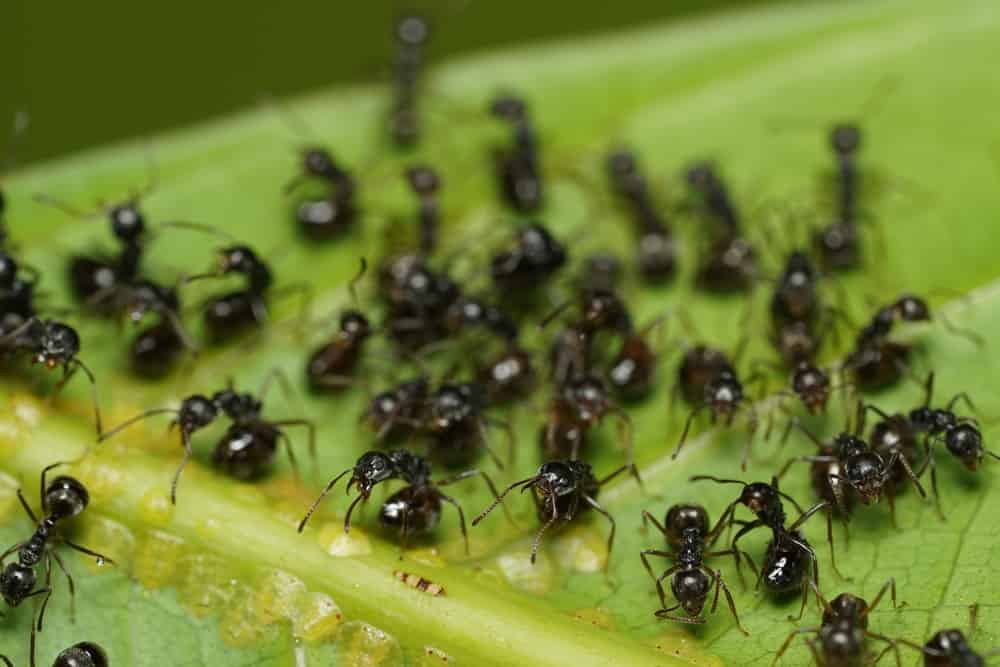
Black garden ants have a slim, long body with a shiny black shade.
©Sufian Hanif/Shutterstock.com
7. Silky Field Ant (Formica subsericea)
The silky field ant’s workers typically measure 6 – 9 millimeters long, and the queen is usually 8 – 12 mm long. These ants have different shades ranging from brown, yellow, red, or black. They typically make their homes anywhere on a flat surface.
Although the worker ants species move fast, their speed doesn’t necessarily translate to aggressiveness; they’re pretty timid. Their timidity makes them easy targets for slavemaker ants, and you might find them working in colonies different from their own.
The silk field ants are as anxious as they are timid. It’s therefore easier to trouble them with noise, intense light, or loud vibrations. The queen can panic and eat her eggs if the anxiety intensifies.
Because of their highly subservient nature, the silky field ants can survive even after capturing half the colony members. They only need a sufficient number to provide the queen with enough food.
They feed on honeydew from aphids and soft arthropods. Besides Canada, you can find them in other parts of North America, Asia, and Europe.

Silky field ants have different shades ranging from brown, yellow, red, or black.
©Pascal Guay/Shutterstock.com
8. Formica subintegra emery
Formica subintegra emery ants range in size between 5.5 and 6.5 millimeters. They’re a facultative parasite species similar to slavemaker ants. The Formica subintegra ants are some of the laziest ants you might encounter. Despite their medium size, making them one of the largest ants crawling around Canada, they rarely venture outside their nests.
The only reason they venture outside is to look for colonies to enslave. Their favorite victims are their cousins, Formica fusca cousins. Their queen leads them to a nest where they kill the host queen and take over the colony.
They then spend all their time inside their habitats as the enslaved worker ants provide all the food. Besides looking for ants to enslave, they also steal pupae of other closely related ants to get workers for their colonies.
Members of these ant species secrete pheromones that reduce the host defenders’ aggression. They, therefore, don’t have a specific habitat type since all they do is take over the mounds made by their less aggressive hosts.

These ants actively seek out colonies to conquer and enslave, with a particular preference for their cousins,
Formica fusca.
©April Nobile / © AntWeb.org – License
9. Hercules Ants (Camponotus herculeanus)
These carpenter ants get their name from the legend of Hercules owing to their humongous size. Queens can grow to a maximum length of 17 millimeters, while males grow to about 11mm.
Worker ants use their enormous jaws to chew through wood and walls of homes to create a habitat. Although workers have red legs and a reddish middle segment, they’re usually dark.
Their abdomens have thicker hairs that help distinguish them from other ants of the genus Camponotus. The natural habitat of these ants is in forests, where they burrow into living and rotting trees to build nests.
As we continue to take over more and more forest land, the Hercules ants are left with no choice but to build a home out of our house walls. They also have a peculiar ability to build long nests. Their nests can extend as long as 10 meters inside a tree.
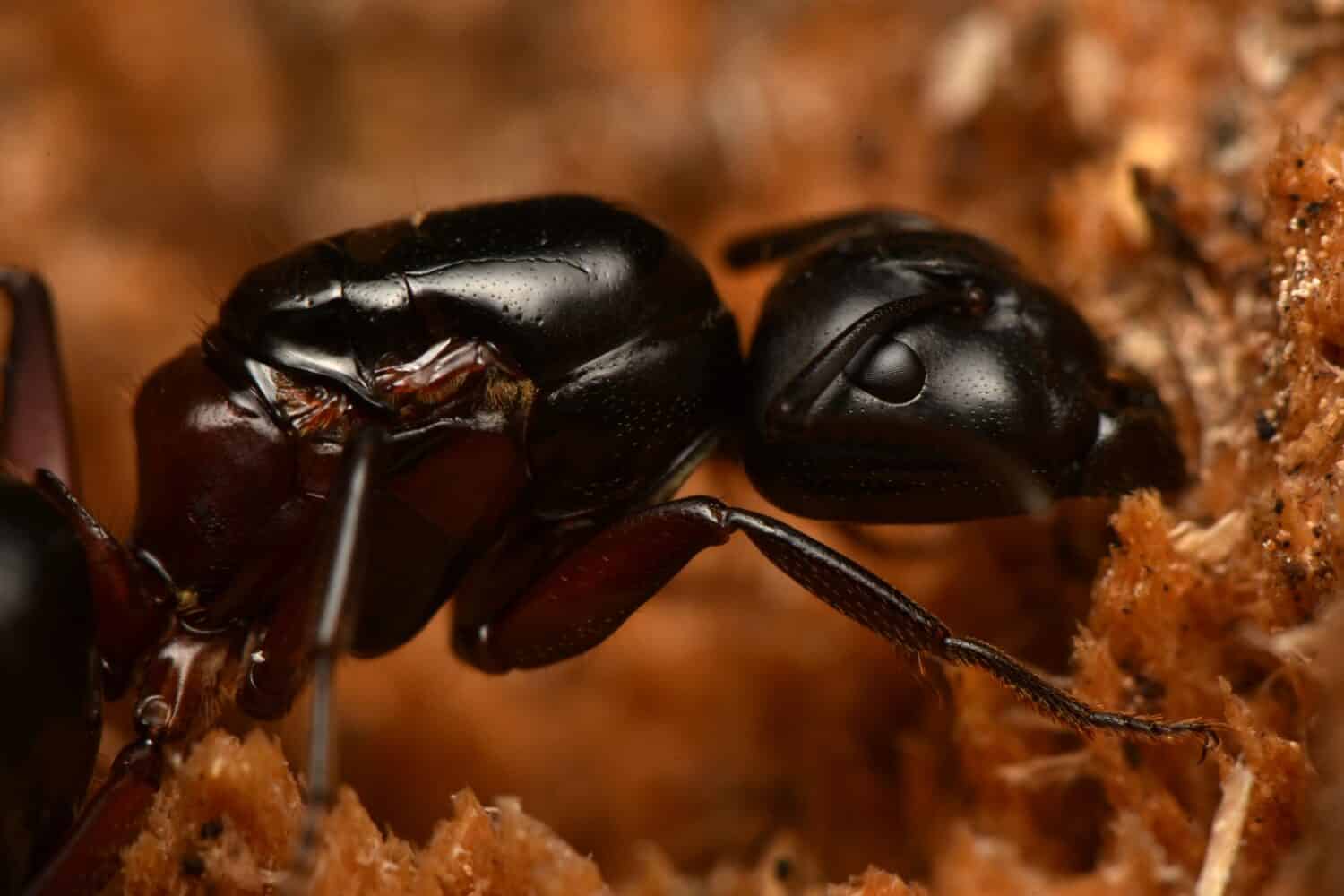
Hercules ants are able to chew through wood and walls of houses to build their habitats.
©Marek Velechovsky/Shutterstock.com
10. Harvester Ants (Pogonomyrmex barbatus)
Harvester ants range between 4.5 mm to 13 mm long and vary in colors of black, red, or brown. In Canada, the most famous are red harvester ants. Harvester ants have hairs on the lower side of their head; their scientific name translates to ‘bearded ant.”
They’re popular for collecting seeds using the hairs on their abdomen. These tiny hairs also help them collect soil when building their nests. Harvester ants also have painful stings.
Harvester ants are known for being quite aggressive, mounting vicious fights to defend their colonies. They prefer exposed areas for their nests that can go as far down as 2.5 meters. The best indication of their presence is an area devoid of vegetation with seed scatterings at the entrance.
These seed scattering benefits both plants and ants. The ants have food, while the plants get an avenue to disperse their seeds. People often mistake red harvesting ants for fire ants, although they have no relation. They only share the red coloration, but harvesting ants are larger than the marauding fire ants.
Fun Fact: Harvesting ants are incredible foragers, with 90% of foragers always returning with food for the colony. That allows the ant settlement never to lack food throughout the year.

Red harvesting ants are commonly mistaken for fire ants, despite having no relation to each other.
©Kessler Bowman/Shutterstock.com
Interesting Facts About 10 The Largest Ants Crawling Around In Canada
There are three exciting things worth noting about the larger ants in Canada:
1. The Large Bodies Help With Heat Conservation
Canada usually has cold winters therefore, an explanation for some Canadian ants being large is to help them conserve heat. Temperature changes quickly affect ants since they’re ectotherms that depend on external temperature to regulate their body temperature.
The ants also usually have darker colors that help to prevent heat loss and brave the cold of winter.
2. These Large Ants Aren’t Particularly Aggressive
Unless their nests are threatened, giant Canadian ants rarely attack. Humans should avoid contact with ants and respect their natural habitats. Unless they infest your home, you have no reason to call the exterminators.
3. Large Ants In Canada Play An Integral Ecosystem Role
Although Camponotus ants can sometimes bore through the wooden structure of homes, they play an essential role in maintaining the balance of the ecosystem. By foraging through wood with their jaws, they help break down rotting wood and enable nutrient cycling.
On the other hand, harvesting ants help plant seed dispersal, which is integral in maintaining forest cover.
Canada’s Giants of the Ant World
Many of the largest ants crawling around Canada belong to the carpenter species. This species is the country’s largest of the over 100 ant species. Their queens can grow as long as 0.5 inches, and the males and worker ants are as huge.
You’d think the slavemaker ants’ massive bodies would ensure they work for their food; instead, they use their size to enslave other ants.
Silky field ants are easily scared despite being giant ants. Noise and vibration affect them, causing them to move fast in all directions. They’re the other most likely ants slavemaker ants enslave. Harvesting ants, on the other hand, use their extended body sizes to carry twice their weight for food and dispersal seeds.
Although larger ants, such as the giant Amazonian ant, stalk the world, these Canadian giant ants can hold their own on the list of the largest ants.
The photo featured at the top of this post is © Poravute Siriphiroon/Shutterstock.com
Thank you for reading! Have some feedback for us? Contact the AZ Animals editorial team.





